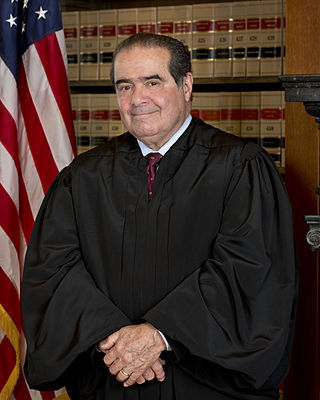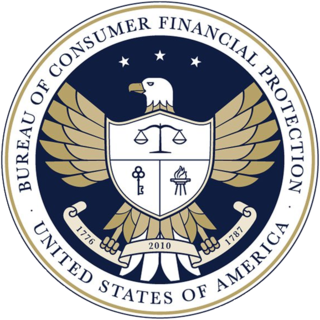
Theodore Bevry Olson is an American lawyer who served as the 42nd solicitor general of the United States from 2001 until 2004. Previously, Olson served as the United States Assistant Attorney General of the Office of Legal Counsel (1981–1984) under President Ronald Reagan. He remains a practicing attorney at the law firm of Gibson, Dunn & Crutcher.

Antonin Gregory Scalia was an American jurist who served as an associate justice of the Supreme Court of the United States from 1986 until his death in 2016. He was described as the intellectual anchor for the originalist and textualist position in the U.S. Supreme Court's conservative wing. For catalyzing an originalist and textualist movement in American law, he has been described as one of the most influential jurists of the twentieth century, and one of the most important justices in the history of the Supreme Court. Scalia was posthumously awarded the Presidential Medal of Freedom in 2018, and the Antonin Scalia Law School at George Mason University was named in his honor.
Myers v. United States, 272 U.S. 52 (1926), was a United States Supreme Court decision ruling that the President has the exclusive power to remove executive branch officials, and does not need the approval of the Senate or any other legislative body. It was distinguished in 1935 by Humphrey's Executor v. United States. However, in Seila Law LLC v. Consumer Financial Protection Bureau (2020), the Supreme Court interpreted Myers as establishing that the President generally has unencumbered removal power. Myers was the first Supreme Court case to address the president's removal powers.
Hamdi v. Rumsfeld, 542 U.S. 507 (2004), is a United States Supreme Court case in which the Court recognized the power of the U.S. government to detain enemy combatants, including U.S. citizens, but ruled that detainees who are U.S. citizens must have the rights of due process, and the ability to challenge their enemy combatant status before an impartial authority.
Clinton v. City of New York, 524 U.S. 417 (1998), was a landmark decision by the Supreme Court of the United States in which the Court held, 6–3, that the line-item veto, as granted in the Line Item Veto Act of 1996, violated the Presentment Clause of the United States Constitution because it impermissibly gave the President of the United States the power to unilaterally amend or repeal parts of statutes that had been duly passed by the United States Congress. Justice John Paul Stevens wrote for the six-justice majority that the line-item veto gave the President power over legislation unintended by the Constitution, and was therefore an overstep in their duties.

The Ethics in Government Act of 1978 is a United States federal law that was passed in the wake of the Nixon Watergate scandal and the Saturday Night Massacre. It was intended to fight corruption in government.

The United States Tax Court is a federal trial court of record established by Congress under Article I of the U.S. Constitution, section 8 of which provides that the Congress has the power to "constitute Tribunals inferior to the supreme Court". The Tax Court specializes in adjudicating disputes over federal income tax, generally prior to the time at which formal tax assessments are made by the Internal Revenue Service.
Hamdan v. Rumsfeld, 548 U.S. 557 (2006), is a United States Supreme Court case in which the Court held that military commissions set up by the Bush administration to try detainees at Guantanamo Bay violated both the Uniform Code of Military Justice (UCMJ) and the Geneva Conventions ratified by the U.S.
In American law, the unitary executive theory is a Constitutional law theory according to which the President of the United States has sole authority over the executive branch. It is "an expansive interpretation of presidential power that aims to centralize greater control over the government in the White House". The theory often comes up in jurisprudential disagreements about the president's ability to remove employees within the executive branch; transparency and access to information; discretion over the implementation of new laws; and the ability to influence agencies' rule-making. There is disagreement about the doctrine's strength and scope, with more expansive versions of the theory becoming the focus of modern political debate. These expansive versions are controversial for both constitutional and practical reasons. Since the Reagan administration, the Supreme Court has embraced a stronger unitary executive, which has been championed primarily by its conservative justices, the Federalist Society, and the Heritage Foundation.
Plaut v. Spendthrift Farm, Inc., 514 U.S. 211 (1995), was a landmark case about separation of powers in which the Supreme Court of the United States held that Congress may not retroactively require federal courts to reopen final judgments. Writing for the Court, Justice Scalia asserted that such action amounted to an unauthorized encroachment by Congress upon the powers of the judiciary and therefore violated the constitutional principle of separation of powers.
The Appointments Clause of the United States Constitution empowers the President of the United States to nominate and, with the advice and consent (confirmation) of the United States Senate, appoint public officials. Although the Senate must confirm certain principal officers, Congress may by law invest the appointment of "inferior" officers to the President alone, or to courts of law or heads of departments.
Humphrey's Executor v. United States, 295 U.S. 602 (1935), was a Supreme Court of the United States case decided regarding whether the United States President has the power to remove executive officials of a quasi-legislative or quasi-judicial administrative body for reasons other than what is allowed by Congress. The Court held that the President did not have this power. However, Humphrey's has been distinguished by Seila Law LLC v. Consumer Financial Protection Bureau. In Seila, Chief Justice John Roberts described Humphrey's as holding that Congress may occasionally create independent agencies with removal only for cause if such agencies share the characteristics of the FTC in 1935.

William Hubbs Rehnquist was an American attorney and jurist who served as the 16th chief justice of the United States from 1986 until his death in 2005, having previously been an associate justice from 1972 to 1986. Considered a staunch conservative, Rehnquist favored a conception of federalism that emphasized the Tenth Amendment's reservation of powers to the states. Under this view of federalism, the Court, for the first time since the 1930s, struck down an act of Congress as exceeding its power under the Commerce Clause.
Free Enterprise Fund v. Public Company Accounting Oversight Board, 561 U.S. 477 (2010), was a 5–4 decision by the U.S. Supreme Court in which the Court ruled that laws enabling inferior officers of the United States to be insulated from the Presidential removal authority with two levels of "for cause" removal violated Article Two of the United States Constitution.

Josephine Laura Staton is a United States district judge of the United States District Court for the Central District of California.

The Consumer Financial Protection Bureau (CFPB) is an independent agency of the United States government responsible for consumer protection in the financial sector. CFPB's jurisdiction includes banks, credit unions, securities firms, payday lenders, mortgage-servicing operations, foreclosure relief services, debt collectors, for-profit colleges, and other financial companies operating in the United States. Since its founding, the CFPB has used technology tools to monitor how financial entities used social media and algorithms to target consumers.
Bank Markazi v. Peterson, 578 U.S. 212 (2016), was a United States Supreme Court case that found that a law which only applied to a specific case, identified by docket number, and eliminated all of the defenses one party had raised does not violate the separation of powers in the United States Constitution between the legislative (Congress) and judicial branches of government. The plaintiffs, in the case had initially obtained judgments against Iran for its role in supporting state-sponsored terrorism, particularly the 1983 Beirut barracks bombings and 1996 Khobar Towers bombing, and sought execution against a bank account in New York held, through European intermediaries, on behalf of Bank Markazi, the Central Bank of the Islamic Republic of Iran. The plaintiffs obtained court orders preventing the transfer of funds from the account in 2008 and initiated their lawsuit in 2010. Bank Markazi raised several defenses, including that the account was not an asset of the bank, but rather an asset of its European intermediary, under both New York state property law and §201(a) of the Terrorism Risk Insurance Act. In response to concerns that existing laws were insufficient for the account to be used to settle the judgments, Congress added an amendment to a 2012 bill, codified after enactment as 22 U.S.C. § 8772, that identified the pending lawsuit by docket number, applied only to the assets in the identified case, and effectively abrogated every legal basis available to Bank Markazi to prevent the plaintiffs from executing their claims against the account. Bank Markazi then argued that § 8772 was an unconstitutional breach of the separation of power between the legislative and judicial branches of government, because it effectively directed a particular result in a single case without changing the generally applicable law. The United States District Court for the Southern District of New York and, on appeal, the United States Court of Appeals for the Second Circuit both upheld the constitutionality of § 8772 and cleared the way for the plaintiffs to execute their judgments against the account, which held about $1.75 billion in cash.
Seila Law LLC v. Consumer Financial Protection Bureau, 591 U.S. 197 (2020) was a U.S. Supreme Court case which determined that the structure of the Consumer Financial Protection Bureau (CFPB), with a single director who could only be removed from office "for cause", violated the separation of powers. Handed down on June 29, 2020, the Court's 5–4 decision created a new test to determine when Congress may limit the power of the president of the United States to remove an officer of the United States from office.
Collins v. Yellen, 594 U.S. ___ (2021), was a United States Supreme Court case dealing with the structure of the Federal Housing Finance Agency (FHFA). The case follows on the Court's prior ruling in Seila Law LLC v. Consumer Financial Protection Bureau, which found that the establishing structure of the Consumer Financial Protection Bureau (CFPB), with a single director who could only be removed from office "for cause", violated the separation of powers; the FHFA shares a similar structure as the CFPB. The case extends the legal challenge to the federal takeover of Fannie Mae and Freddie Mac in 2008.
The Decision of 1789 refers to a month-long constitutional debate that occurred during the first session of the United States House of Representatives as to whether Article Two of the United States Constitution granted the president the power to remove officers of the United States at will. It has been called "the first significant legislative construction of the Constitution". The debate centered around "a bill that would create a Department of Foreign Affairs"—the precursor to the Department of State—and which branch of government would have the power to remove officers from that department.







